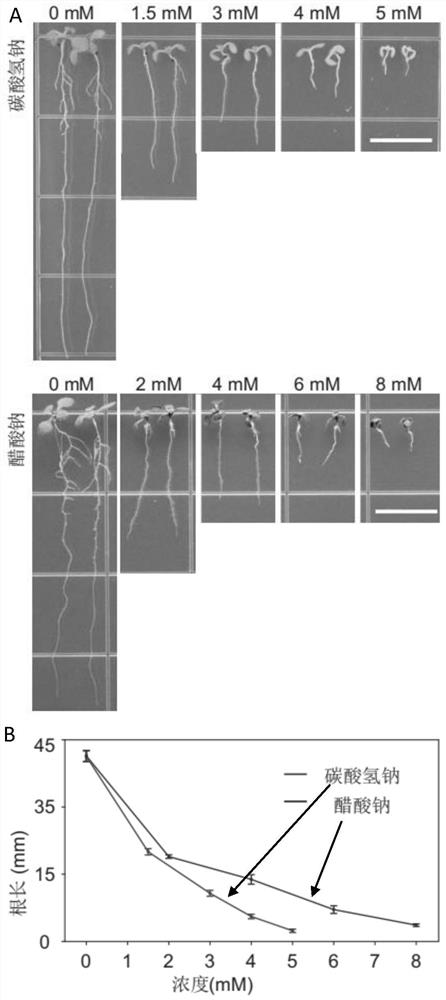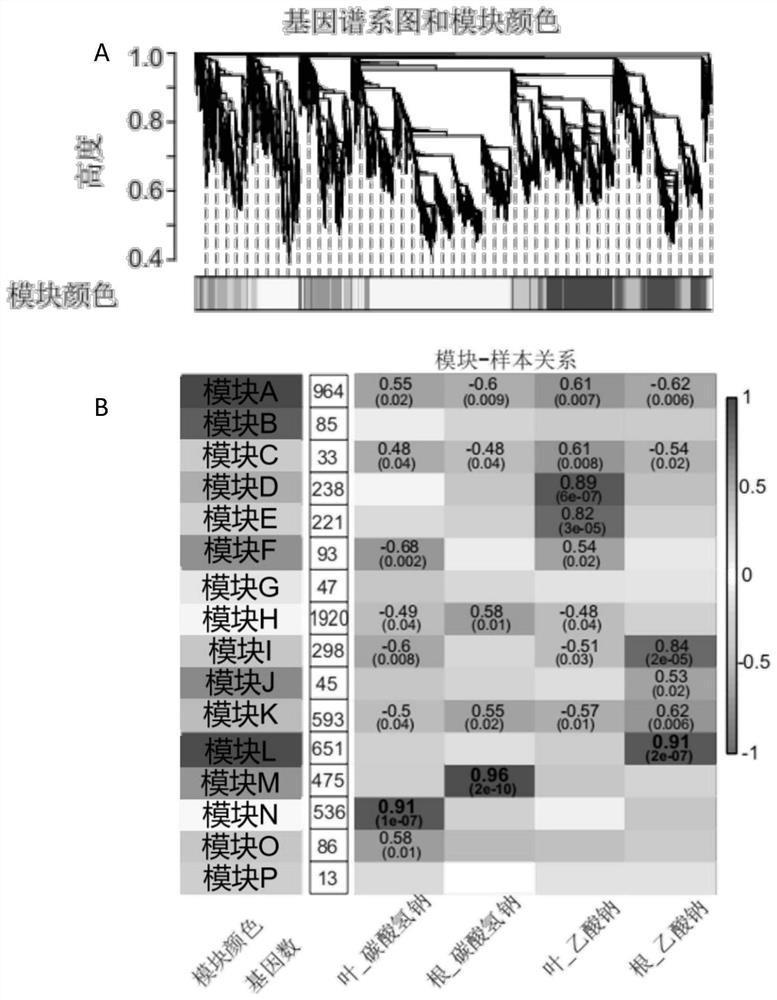Application of ebs1 gene in enhancing Arabidopsis resistance to bicarbonate stress
A bicarbonate, Arabidopsis technology, applied in application, genetic engineering, plant genetic improvement and other directions, can solve the problem of high phytotoxic effect, and achieve the effect of enhanced tolerance and robust root growth
- Summary
- Abstract
- Description
- Claims
- Application Information
AI Technical Summary
Problems solved by technology
Method used
Image
Examples
Embodiment 1
[0043] Example 1 Arabidopsis to NaHCO 3 , NaOAc dose-response
[0044] This embodiment analyzes Arabidopsis to NaHCO 3 , NaOAc dose response.
[0045] The specific method is as follows:
[0046] (1) Place the sterilized wild-type Arabidopsis Col-0 seeds on the MS medium (1% sucrose) containing the specified alkaline salt, and set the concentration range of 0-5 μM NaHCO 3 In the experimental group, a gradient was set for every 1.5 μM and for the NaOAc experimental group with a concentration range of 0-8 μM, a gradient was set for every 2 μM. After two days of vernalization at 4°C, the Arabidopsis seedlings were moved to the growth chamber for culture Cultivated in the box, Arabidopsis culture conditions are light intensity 150-200μmol·m -2 the s -2 , 60% humidity, 12 / 12h (light / dark) photoperiod.
[0047] (2) Take photos and record after 10 days of culture, measure root length with ImageJ, and statistically analyze the data by Student's t test or linear mixed model.
[0...
Embodiment 2
[0049] Example 2 RNA-Seq analysis of Arabidopsis in NaHCO 3 , Differential gene expression after NaOAc treatment
[0050] in NaHCO 3 , NaOAc treatment, the root and leaf samples were subjected to RNA sequencing, and then the differentially expressed genes were identified and analyzed.
[0051] The specific method is as follows:
[0052] (1) The seedlings grown for 10 days were transferred to 1 / 2MS medium containing or not containing sodium bicarbonate (3mM) and sodium acetate (4mM) (the treatment concentration was selected according to Example 1). Four days later, the roots and leaves of these seedlings were collected separately. A total of 120 seedlings (40 plants / plate, 3 plates / treatment) were collected for each genotype as a repetition.
[0053] (2) Use MiniBEST universal RNA Extraction Kit ( RNA Plant, Cat.#740949.50, TaKaRa; www.takarabio.com) to extract RNA;
[0054] (3) Illumina HiSeq 4000 is sequenced at 150bp paired ends; fine-tuning -0.38 is used to remove ad...
Embodiment 3
[0058] Example 3 accepts NaHCO 3 Deletion mutants of 13 genes specifically upregulated by NaHCO 3 Sensitivity test
[0059] The 13 gene T-DNA mutants were purchased from NASC (http: / / arabidopsis.info / BasicForm).
[0060] The specific experimental method is as follows:
[0061] (1) Plant 13 mutants and Col-0 in NaHCO-containing 3 (3mM) on the 1 / 2MS culture dish, the cultivation method is consistent with embodiment 1;
[0062] (2) After 10 days, take pictures to record the growth status of the plants, and use ImageJ to measure the root length.
[0063] Result: in NaHCO 3 Sensitivity verification experiments screened out the mutant lines of AT5G07330 (Salk_104370C), AT3G05950 (Salk_038626C) and AT4G17680 (Sail_420_E12) in the sodium bicarbonate treatment environment with poor plant growth status, weak root system, and sensitive to stress. ( Figure 5 A).
PUM
 Login to View More
Login to View More Abstract
Description
Claims
Application Information
 Login to View More
Login to View More - R&D
- Intellectual Property
- Life Sciences
- Materials
- Tech Scout
- Unparalleled Data Quality
- Higher Quality Content
- 60% Fewer Hallucinations
Browse by: Latest US Patents, China's latest patents, Technical Efficacy Thesaurus, Application Domain, Technology Topic, Popular Technical Reports.
© 2025 PatSnap. All rights reserved.Legal|Privacy policy|Modern Slavery Act Transparency Statement|Sitemap|About US| Contact US: help@patsnap.com



